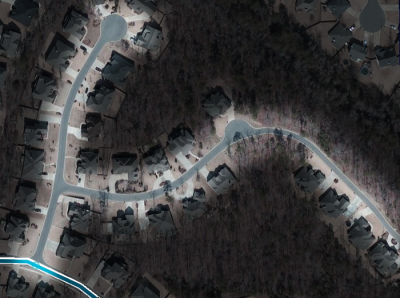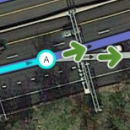This article covers creating and editing road segments. Be sure to read this whole article to ensure you fully understand all aspects of how segments operate in Waze before you start to create and edit roads on the map.
Criando uma nova rua
Se você encontrar uma rua que não existe no mapa do Waze (acontece frequentemente após uma atualização da foto do satélite) siga os seguintes passos para adicionar essa rua. Nesse tutorial iremos adicionar as ruas que faltam da foto abaixo.
Amplie o zoom do mapa para visualizar a área a ser editada. Usando um zoom maior é possível ver as curvas que a rua faz e desenha-las corretamente no mapa do Waze.
Há 5 passos para adicionar uma rua nova corretamente ao mapa do Waze:
- Desenhe a rua
- Defina ou confirme as propriedades da rua
- Conecte a rua a outras rua(s) ou nó(s)
- Define as curvas permitidas
- Salve as alterações
Desenhando a rua
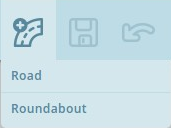
Coloque o ponteiro do mouse sobre o texto 'Via' no topo do WME na toolbar. Você também pode usar uma keyboard shortcut, nesse caso é a letra i, para inserir. Mova o ponteiro para o local em que quer iniciar a rua, pode ser um local vazio do mapa, um nó existente ou num ponto de uma outra rua já existente. Após fazer o primeiro clique um nó azul aparecerá no local e ao arrastar o mouse para outro local, uma linha azul seguirá o ponteiro.
Quando você passa o ponteiro sobre um segmento existente, este segmento será destacado mostrando pontos nos quais é possivel criar um novo segmento conectado ao segmento já existente.
Mova o mouse ao longo do percurso da rua, siga a foto de satélite ou os pontos GPS. Sempre que mover o mouse e fizqer um clique será adicionado um geometry node, continue repetindo esse processo de mover/clicar até o fim da nova rua, utilize o duplo clique para finalizar a rua. Você sairá do modo desenho de segmento e a rua ficará laranja, isso indica que há uma alteração não salva daquele segmento. Não se preocupe se cometeu um erro ao desenhar a forma da rua. Basta clicar no segmento adicionado, em seguida é possivel adicionar, remover ou reposicionar nós geometricos. Se quiser remover a rua adicionada basta clicar nela e em seduida na tecla delete ou no ícone de lixeira na barra superior.
No nosso exemplo existe uma outra rua na mesma área faltando, podemos adicionar outra rua ao mapa sem precisar salvar a primeira. A próxima imagem mostra a segunda rua já adicionada e conectada a primera rua criada.
Neste momento você pode salvar as alterações se quiser. No entanto o processo de adicionar corretamente as ruas ainda não foi concluido. Dependendo das configurações do WME sua nova rua adicionada pode ser de mão única ou dupla e pode ter as curvas permitidas ou proibidas. Esses detalhes precisem ser ajustados para as ruas adicionadas, além disso é preciso definir se a rua tem nome de rua e cidade. É necessário definir cidade/estado antes que a rua possa aparecer no mapa.
Atenção: Ao adicionar ruas do tipo roundabouts e loops, siga as instruções especificas para este tipo de rua.
Confirme a rua definindo detalhes da rua
Novos segmentos criados através da função Pavimentar Rua do aplicativo não são imediatamente adicionadas ao mapa do Waze. É necessário primeiro confirmar o estado, cidade e nome de rua do segmento, essa ação precisar ser realizada por um editor no WME. O editor também terá que conectar essa rua a outra(s) rua(s) e/ou nó(s) para tornar o segmento utilizavel.
Segmentos em
Vermelho
No editor de Mapas as Ruas em Vermelho são ruas que não tem os detalhes estado/cidade/nome de rua definidios, são conhecidos comummente na comunidade como ruas em vermelho ou ruas não confirmadas. Para a rua ser adicionada corretamente no mapa do Waze é necessário um editor definir estado, cidade, nome de rua, tipo de via, direção e curvas permitidas.
| ??? Paved roads do not appear until being "touched" in the editor. This does not apply to roads created in the editor; when created in WME, roads can appear on the Waze app even if they are missing key properties. ??? |
Para confirmar uma rua, clique em um ou mais segmentos com o ponteiro do mouse. Você pode definir apenas um conjunto de propriedades por vez, mas pode selecionar vários segmentos para definir os detalhes de vários segmentos ao mesmo tempo. Para selecionar vários segmentos utilize a tecla CTRL e em seguida clique nos segmentos. Observe que a primera rua que adicionamos é composta por dois segmentos, essa divisão aconteceu ao adicionarmos a segunda rua.
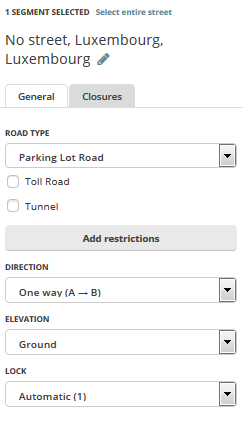
Para editar o endereço do(s) segmento(s) selecionado(s) encontre a frase Sem nome de rua no canto superior esquerdo do editor, clique nele e aparecerá um conjunto de propriedades da rua a serem definidas (imagem a direita). Verifique se os parâmetros País e Estado estão corretos, pode haver erro próximo da fronteira, em seguida defina o estado, cidade e nome de rua. Um segmento pode não pertencer a uma cidade ou não ter nome de rua, nestes casos clique na caixa sem nome do parâmetro indefinido.
Rotatórias roundabouts não devem ter nome de rua definidos, então use defina o nome de rua como sendo sem nome. Isso permitirá instruções corretas de direção.
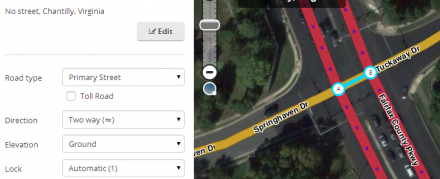
Para segmentos que conectam duas vias de sentido único utilize as regras apropriadas da página Como categorizar e nomear vias.
| Ao terminar de definir os parâmetros da rua, clique no botão Aplicar antes de salvar, se não clicar neste botão as alterações de parâmetros não serão salvas e serão descartadas pelo WME sem nenhum aviso. Clicar em outro objeto no WME também descartará as alterações. Lembre-se de clicar em aplicar logo em seguida que terminar de alterar os parâmetros para não perder suas alterações. |
Defina Tipo de Via, Direção e Elevação
Defina cada um dos parâmetros Road Type, Direction, and Elevation. No exemplo utilizamos rua para o tipo da via, o sentido é mão dupla e a elevação é solo (não há ruas acima ou abaixo).
Releia a página determining one-way streets para mais informações sobre sentido.
- Note que o sentido sendo definido como 'desconhecido' não irá prevenir o Waze de rotear por essa rua. 'Desconhecido' é visto pelo servidor de rotas como 'Não definido', nesse caso o sistema do Waze irá tentar definir automaticamente o sentido da via baseado em motoristas passando pelo segmento.
Você pode escolher salvar nesse momento, no entanto ainda há uma passo para concluir este processo: definir curvas permitidas.
Definindo conversões permitidas (conexões)
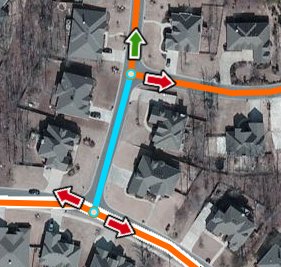
Adicionamos as ruas e as confirmamos, mas não definimos as conversões permitidas de e para estes segmentos. No mundo real há barreiras e placas que impedem transitar em certas direções, mesmo que as ruas estejam conectadas umas as outras. No nosso exemplo residencial não há nenhuma proibição, mas na imagem a esquerda temos setas em vermelho, essas setas com essa cor indicam que normalmente o Waze não irá sugerir percursos por esse caminho. Clicando na seta vermelha irá torna-la verde, isso permite um percurso por esse caminho. Isso precisa ser feito para cada segmento adicionado ao mapa, a configuração padrão do WME é adicionar novos segmentos com as conversões proibidas.
Em situações em que há conversões não permitidas, clique na seta para torna-la vermelha na direção que for proibido transitar daquele segmento.

Se todas as conversões forem permitidas em um nó de junção há uma maneira mais fácil para permitir todas as conversões. Selecione o nó, ele mudará da cor preta para azul com borda branca. Note que se o segmento ao qual o nó pertence estiver clicado, será necessário primeiro clicar em outro local do mapa ou apertar a tecla ESC para remover a seleção do segmento antes de ser possível selecionar o nó de junção.
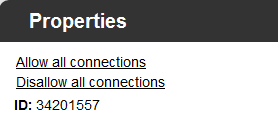
Na painel esquerdo irão aparecer opções para o nó selecionado. Dependendo da situação atual da junção, um ou ambos os botões Permitir todas as conversões/Proibir todas as conversões irão aparecer. Por exemplo se todas as conversões forem permitidas em um nó, então apenas o botão Proibir todas as conversões será mostrado.
Para permitir todas as conversões na interseção clique no botão permitir todas as conversões da junção. Outra opção é utilizar as teclas de atalho: w para permitir todas as conversões e q para proibir todas as conversões no nó. Devido a erros antigos em cruzamentos ao permitir todas as conversões em um nó é recomendado primeiro proibir todas as conversões e em seguida permitir todas as conversões.
Outras teclas de atalho úteis são:
| a - Alterna entre fazer as setas clicaveis (opacas) ou não clicaveis (transparentes). A transparência permite selecionar objetos abaixo das setas. |  |
 |
Para visualizar todos os Atalhos de Teclado aperte na tecla ? do teclado.
Quando conversões ou parte de uma são restritos em certos horários do dia ou dias da semana, você pode utilizar a função scheduled restrictions.
Em geral ao incluir novas ruas a maioria das conversões são permitidas e o sentido é mão dupla, é mais eficiente alterar a configuração do WME que permite criar "Novas vias com todas as conversões permitidas" e "Novas vias como mão dupla" na aba configurações do WME.
Veja a seção restrições de conversão para mais informações sobre as setas de conversões.
Salve
Se salvou seu progresso ou não, clique o botão Salvar (ou use a tecla de atalho Ctrl + s) para enviar todas as suas atualizações ao servidor do Waze para processamento. Após as alterações serem salvas, caso não ocorrram erros, o mapa será atualizado para mostrar as suas alterações.
É uma boa prática salvar suas alterações com frequência, certamente após 10 alterações não salvas. As vezes um erro de servidor irá preveni-lo de salvar e será necessário desfazer varias alterações até encontrar o problema, a alteração com erro pode até ser a primeira alteração realizadas. Salvar com frequencia evita o risco de perder o trabalho já executando.
Editando ruas existentes
Editar um segmento de rua já existente não difere muito de criar uma rua nova. Todas as alterações descritas abaixo servem também para um segmento recém criado que ainda não foi salvo.
Ajustando geometria do segmento (nós)
Ajustar geometria do segmento é alterar a forma ou aparência do segmento de rua. Os segmentos de rua representam ruas reais e podem estar desalinhados ou mapeados no local errado. As vezes precisamos realinhar os segmentos baseado em informações atualizadas. Também podemos precisar alterar a geometria para fornecer instruções corretas no aplicativo.

Para iniciar o ajuste de geometria de um segmento clique no segmento. Ao passar o mouse sobre o segmento nós de tamanho médio brancos geometry nodes com borda azul e nós pequenos inter-geometry nodes azul claro com borda azul irão aparecer no segmento. Ambos os nós são arrastaveis para que possa reposiciona-los onde desejar. Ao arrastar um nó inter-geometrico ele irá se transformar em um nó geometrico.
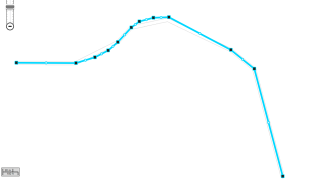
Para remover um nó pare o cursor do mouse sobre um nó e aperte na tecla d do teclado. Isso só funciona com nós geometricos, não com nós inter-geometricos.
Dica: Alinhe segmentos rapidamente:Se tiver um segmento que precisar remover toda a geometria rapidamente, selecione o segmento e segure a tecla d. Ao passar a seta do mouse sobre os nós eles serão automaticamente removidos, para parar de remover solte a tecla d.

Quando terminar as alterações, salve. O mapa será exibido agora com as alterações realizadas.geometry. Há um video mostrando essas operações, você pode ver o video ajustando geometria aqui.
Junç"oes
Before making any change to a junction, be sure to review the Junction Style Guide for information on the best practices for creating junctions. There are many times when a junction may be drawn in a way that does not seem logical, but it is very important to the navigation engine in Waze.
Movendo Junções
Moving a junction is as simple as dragging the junction to another location, however there are geometry nodes (the white circles seen when editing a segment) that might need to be moved or removed.
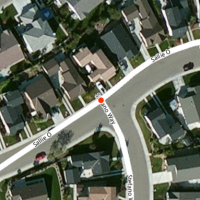
First use the mouse to select the intersection of the road segments. This puts a red dot, circled in white, on the junction. This indicates you are moving all the segments connected to this junction. Note that if the red dot appears transparent, it means that one of the attached road segments is locked above your editing rank, and the junction cannot be moved by you. Release the mouse button and move the mouse away until the cursor appears as a 4-way crossed arrow ![]() .
.
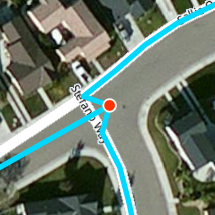
With the cursor as a crossed arrow, select the junction again and drag it to the desired location. The harsh angles in the segments in this example are caused by the geometry nodes and need to be adjusted. It is important to position the junction in a location that is not on top of a segment. This makes it difficult to adjust the geometry nodes, and in some cases tells the editor to merge junctions if one is present below the junction you are moving.
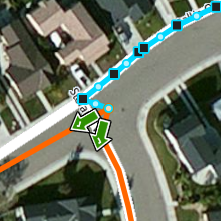
The black geometry nodes can be moved, removed, or added as explained in detail above. Adjust them to align with the aerial views or the GPS tracks.
Moving one junction onto another junction
If two junctions are disconnected from each other, but should be joined into one junction, then dragging one of the junction nodes until it "snaps" to and connects to the other junction node will bring them together. Warning! Only use this technique if the two junctions are disconnected from each other. If there is a segment connecting the two, you could accidentally delete the segment in the process. This would also delete any traffic data and house numbers associated with the deleted segment.
Removing junctions with only two segments
There are times when only two segments are joined at a junction. In general this is not a problem, but it can slow down editing and it may be the source of incorrect turn restrictions and bad routing. So the best practice is to delete these junctions when found. However, it is very important to study the two segments before merging, to ensure the junction is not there for a purpose.
| Legitimate Reasons for Two-segment Junctions |
|---|
| Necessary junctions |
Once you are certain there is no reason to have the extra junction, there are two methods to remove it. One method highlights the junction and deletes it and the second highlights the two segments and bridges them together.
Delete key or trash can icon
This method is the preferred method, because it enables the WME to alert you when there are legitimate differences between the segments. With the mouse select the junction point between the two segments. Look for the trash can icon at the upper right corner of the WME screen. If it appears press it to remove the junction. Alternatively, the Delete or Del key (not Backspace) removes the junction.
Deletion of a node automatically places a geometry node at that point. If you need to remove the point, you can do so by highlighting the segment and hovering the mouse over the point of the prior junction. The WME displays the point and you can press the d key to remove it.
| If the trash can icon does not appear, something about those two segments is different, possibly the city name, street name, road type, direction of travel, speed limit, etc. |
Bridge segments
Generally do not use this method because it has two additional side effects that are not generally desired.
- It increases the elevation of the resulting single segment by one.
- It disconnects any other segments at that junction point, but leaves it directly below the geometry node potentially causing automated map problems if not moved.

With the mouse, select one of the segments. Then, while holding down the multi-select key (Control for Windows/Linux and Command for Mac) select the second segment. If the two segments have the same properties including direction, a small bridge icon appears above the junction. Click the bridge to merge the two segments, eliminating the junction between them. A geometry node is placed where the junction was previously located. To remove the node (if necessary), select the segment and hover the mouse near the old junction. The geometry node should be displayed. Then, press the d key to remove the unwanted node. When the segments are different, the bridge icon does not appear at the junction.
Cut a segment to create a new junction
If it is necessary to change road information in the middle of a segment (road name, direction, city, type, or other information changes at that point), you need to create a junction at that point. One way to do this is to create a new road connected to the previous road. Begin or end the new road on the previous road to create a new junction. Then delete the new road -- the junction remains, and the previous road segment has been cut at the point where you created and deleted the road.
Allow/Disallow connections
Changing the allowed and disallowed turns in a junction follows the same procedure for controlling them when updating a road segment described above.
(Re)Moving a road from a junction
Updating road details
The details of a road can be entered as discussed with regard to confirming the details of a new road above. The procedure is the same for updating the details of an existing road segment.
To update details, first, select the segment(s) you need to update. Click on the segment and the segment turns blue.

Multiple segments may be selected by holding down the modifier key and clicking additional segments. The modifier key for Mac is the command key, for Windows the control key and for Linux the control key. Each selected segment turns blue.

Once selected, if the General tab is visible on the left side of the editor.
Address Properties
At the top of the properties toolbox are the address fields. The address fields include the street name, city name, State (currently only in the United States) and country. To edit the address details, click the Edit button (or press the 'e' shortcut key). This enables editing of fields above it.
The Country (and State) fields may be updated by selecting a different country (or state) from the dropdown selections. Selections are provided only for countries (or states) that are present on other nearby road segments.
The city and street names may be updated by typing a new name. See the naming guidelines for guidance on choosing the correct street name. As a name is typed, Waze provides a list of similar names. These similar entries can be selected by clicking them. If the segment is in a location outside a city, the "None" check box should be selected and the city name left blank. If the road does not have a name, the "None" check box should be selected and street name left blank. Entries must be present for each address property. To eliminate a city name or street name the appropriate "None" boxes must be checked. When complete, click the Apply button. If no changes are to be made, click the Cancel button.
If the above Address Properties are not set for a segment, the road displays as a red road . This process is part of the road verification process to indicate in WME that the road needs these properties added. See the section on confirming details for more information on red roads.
Alternate street names
The subsection Alternate street names: lists the other names associated with all currently highlighted segments. It does not isolate individual alternate names for each segment, so if you want to be sure all the highlighted segments have a specific alternate name add it all the segments. For any segments that already have the alternate name, it will not be duplicated.
The hyperlink titled Add alternate name brings up two selection boxes for the City name and Street name. If the City name is not applicable, select the None check box. Enter the street name and press Apply or hit the Enter key on the keyboard. This adds that name to the currently highlighted segments.
To delete an alternate street name, click the ![]() next to the alternate name to be deleted. This deletes the alternate name for the highlighted segments.
next to the alternate name to be deleted. This deletes the alternate name for the highlighted segments.
A future version of the Waze Map Editor is being considered to include road shields as part of the alternate street name field.
Road Properties
| It is important to follow the guidelines for setting road properties established by your country or region. |
Predefinição:Related The road segment properties are below the address properties on the General Tab.
Road Type
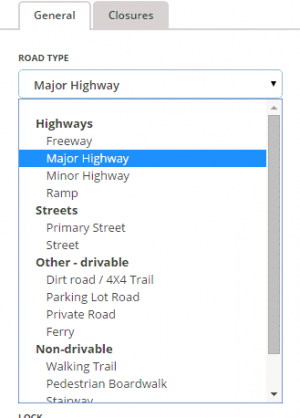
The road type is changed by selecting the appropriate road type from the drop down box.
See the Road types and names page for your country for further guidance on selecting the correct road type.
Special Properties
| The 'Toll road' attribute has moved to the Partial restrictions interface. |

- Unpaved - Select for unpaved segments, see Road types for more information.
- Tunnel - Select for tunnels if the segment meets the guidelines.
- Headlights required - Select for segments with headlight use requirements (Level 4 required).
- Near a carpool/HOV/bus lane - Select for non-restricted lanes adjacent to HOV or carpool configured lanes. See Partial restrictions for more information on HOV or carpool lanes.
- Routing Road Type - Choices of -1, Neutral, +1 (Level 4 required). Raises or lowers the road type used in the routing server calculations. Only applicable to Local Street , Predefinição:Primary Street, Minor Highway , Predefinição:Major Highway, and Predefinição:Freeway. Local Street can only be raised (+1) since already the lowest priority of the main routable road types. Similarly Predefinição:Freeway can only be lowered (-1) since already the highest priority of the main routable road types. Note Predefinição:Freeway is automatically given +1 routing preference by WME after a segment is saved; but it has no effect since Predefinição:Freeway is already the highest priority. Selecting this attribute locks the segment(s) for some editing attributes unless the editor is R4+. Should only be used with concurrence of the State Managers. A map comment is recommended to explain why this setting has been changed.
Road Direction
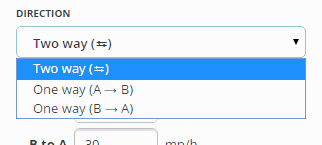
The direction of the road is changed by selecting the appropriate direction from the drop down box.
If traffic may travel both ways on the road, select "Two way." If traffic may travel only one-way on the road in the direction from the ![]() toward the
toward the ![]() select "One way (A→B)." If traffic may travel only one-way on the road in the direction from the
select "One way (A→B)." If traffic may travel only one-way on the road in the direction from the ![]() toward the
toward the ![]() select "One way (B→A)."
select "One way (B→A)."
After the road properties are saved, the direction is indicated by black arrows on the road.

Base mapped roads are originally assigned the direction of unknown. When the direction is set to "Unknown", Waze automatically adjusts the directionality of the road as Wazers drive it. When editing, make every effort to determine the correct direction of the road and choose either "Two-way" or the appropriate "One-way" direction.
See the article determining one-way streets for more information on determining the direction of a road as being one way or two way.
Speed limit
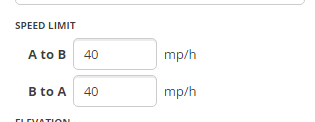
The speed limit fields are shown for the segment. These fields should be updated with the official speed limit as shown on speed limit signs. The speed limit is shown in either km (Km/h) or miles (mp/h), depending on which unit type is selected in the settings tab.

In some locations Waze has run a program to predict speed limits and assign the assumption to segments. When a segment has an assumed speed limit, the limit will be ignored by the app until an editor verifies it. WME displays a Verified check box next to the speed limit field. If you can verify that the speed limit shown is correct, check the Verified box. If you find it to be incorrect, replace the Waze-supplied speed limit with the correct speed limit (there is no need to check the Verified box). Either way, once you save, WME will stop displaying the Verified check box, since it is only needed until verified or corrected.
| Pay attention to the units type displayed next to the speed input field (mph/kph) and be sure to adjust your settings if needed to enter the correct speed.
NOTE: The "Verified" check box will not display when multiple segments are selected, even if they have unverified speed limits. |
- For more details on speed limits policies and how to enter them, see the Speed limits article.
Road elevation
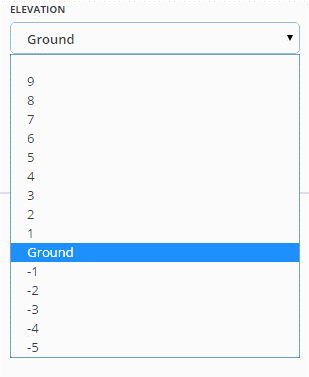
The Road Elevation should be changed where one road passes over another. By default, the Elevation of a segment is Ground (zero). When two segments overlap but do not actually connect in the real world, the value of Elevation for each segment must be different. This ensures that the Waze problem detection system doesn't flag the spot where two segments overlap as a location where a junction might be needed.
The visual representation of the relative Road Elevation is different when viewed in the Waze Map Editor (WME) and the Client application.
1. The Client App displays segment elevation based on the road type only, meaning Freeways are always on top, Major Highways are next, followed by Minor Highways, Ramps next, Primary Streets below all those, and finally Streets are at the bottom. This is the same order seen when setting the road type in the editor.
2. The WME uses the Road Elevation setting to display the relative elevation of the road. It displays the road with the highest "elevation" number at the top of the visual stack and works its way down as would be expected.
Although the client application does not benefit from the Road Elevation setting, it is recommended to set the Road Elevation relative to the physical mapping in the real world to enable possible future Client application updates to show the same visual representation as the WME.
3. Elevation -5 is used for non-drivable roads to help ensure that the routing engine does not try to connect or route drivers from roads onto non-roads by mistake. It acts to prevent false system reporting that the roads should be connected.
See Bridges for more information on elevation.
Road lock
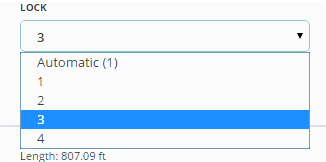
The road lock menu displays locking levels available to each individual user. In the example to the right, the level 4 editor can assign a lock level of 1, 2, 3, or 4. Once the lock level is saved, an editor of a lower level will not be able to make changes to the segment.
See Locking segments for more information.
House numbers

The house numbers is used to create and edit house numbers for named road segments.
See House numbers for more information.
Locked Box
The segment is locked by checking the locked check box which is associated with the segments lock rank. For information on the effect of checking the locked box see Locked Roads.
Changing turn restrictions
Each intersection of two or more segments keeps track of the allowed directions you can turn from one segment to another. Changing these turn restrictions follows the same procedure as outlined above in the section on Set allowed turns.
Separator line (disabled)
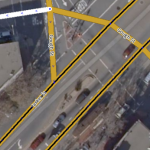
The original map editor before the Waze Map Editor had the ability to add a black separator line down the middle of a road segment. It caused difficulty with map editing and was removed as a feature from the updated WME. There was a time when the line appeared in the WME, but could not be removed. It has since been disabled and no longer appears.
